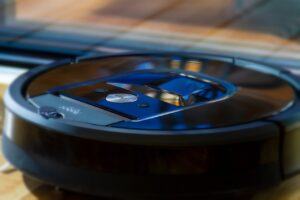Robot vacuums have become increasingly popular in recent years, offering convenience and efficiency in keeping our homes clean. However, one common concern among homeowners is whether these smart devices are prone to falling down stairs.
In this comprehensive guide, we will explore the capabilities of robot vacuums, the advanced technology behind their navigation systems, and how they are designed to prevent falls. Let’s dive in and answer the question: do robot vacuums fall down stairs?
Understanding Robot Vacuum Navigation Systems
To comprehend how robot vacuums navigate and avoid falling down stairs, it’s essential to understand the technology behind their sensors.
Most modern robot vacuums, including popular models like the Roomba series, are equipped with advanced cliff sensors. These sensors utilize infrared light to detect gaps and changes in floor elevation, ensuring safe navigation throughout your home.
How Do Cliff Sensors Work?
Cliff sensors are strategically located underneath the robot vacuum and emit infrared light that bounces back to the device. By analyzing the received signals, the robot vacuum can determine the proximity to the floor and detect any potential cliffs or stairs. When a cliff is detected, the vacuum will change direction or stop altogether to prevent a fall.
Evolution of Cliff Sensor Technology
Over the years, the technology behind cliff sensors has significantly improved, making robot vacuums highly reliable in avoiding falls. Older models may have limitations in their cliff sensor capabilities, but modern robot vacuums boast advanced navigation systems that almost eliminate the risk of falling down stairs.
Do Robot Vacuums Fall Down Stairs?
With the advancements in cliff sensor technology, robot vacuums rarely fall down stairs. However, it’s essential to note that there are still some considerations to keep in mind, especially if your home has multiple levels or staircases.
Outdated Models and Potential Risks
While modern robot vacuums are equipped with reliable cliff sensors, outdated models may still pose a risk of falling down stairs. If you own an older robot vacuum, it’s crucial to assess its navigation capabilities and consider upgrading to a newer model with enhanced safety features.
Limitations in Cleaning Stairs
Although robot vacuums are designed to prevent falls, they are not capable of cleaning stairs. The nature of their compact and flat design restricts their ability to climb or descend stairs effectively. Therefore, if you’re looking for a solution to clean your stairs, you may need to explore alternative options.
Future Innovations
The field of robotics is constantly evolving, and manufacturers are continuously working on developing smarter and more capable robot vacuums. While current models cannot clean stairs, there is potential for future advancements that may introduce robot vacuums capable of climbing and cleaning stairs. Companies like Alphabet, a subsidiary of Google’s parent company, have already made progress in this area, showcasing a two-legged robot capable of performing household chores.
Maintaining Robot Vacuum Safety
To ensure the safe operation of your robot vacuum and minimize the risk of falls, there are several steps you can take:
Regular Cleaning and Maintenance
One of the essential maintenance tasks for robot vacuums is cleaning the cliff sensors. Over time, dust and debris can accumulate on the sensors, potentially impairing their functionality. To clean the sensors, turn the vacuum upside down and wipe each sensor opening with a clean, dry cloth. Regularly performing this maintenance task will help prevent the robot vacuum from misjudging stairs or ledges.
Virtual Walls as a Preventive Measure
To further enhance safety, consider using virtual walls to create invisible barriers that prevent your robot vacuum from approaching stairs or ledges. These devices emit signals that act as boundaries, ensuring that the vacuum stays within the desired cleaning area. Placing virtual walls near staircases can provide an additional layer of protection against falls.
The Role of Robot Vacuums in Cleaning
While robot vacuums may not be suitable for cleaning stairs, they offer numerous benefits when it comes to keeping your home clean and tidy. Understanding their limitations and capabilities will help you make an informed decision about incorporating a robot vacuum into your cleaning routine.
Convenience and Time-Saving
One of the primary advantages of robot vacuums is their ability to operate autonomously. Once programmed or activated, they can navigate your home and clean various surfaces without requiring constant supervision. This frees up your time for other tasks and ensures that your floors remain clean even in your absence.
Daily Maintenance and Surface Cleaning
Robot vacuums excel at performing daily maintenance tasks, ensuring that your floors are consistently kept clean. They are particularly effective in cleaning flat surfaces such as hardwood floors, tile, and carpets. By regularly running your robot vacuum, you can minimize the accumulation of dust, debris, and pet hair, maintaining a cleaner living environment.
Smart Home Integration
Many modern robot vacuums come equipped with smart home integration capabilities, allowing you to control them remotely through smartphone applications or voice commands. This feature enables you to schedule cleaning sessions, monitor the vacuum’s progress, and adjust settings from the convenience of your mobile device.
The Bottom Line
In conclusion, thanks to advanced cliff sensor technology, robot vacuums have significantly reduced the risk of falls down stairs.
While they are not suitable for cleaning stairs themselves, their ability to navigate autonomously and maintain clean flat surfaces makes them valuable additions to your cleaning routine.
As technology continues to advance, we can look forward to future innovations that may introduce robot vacuums capable of tackling stairs.
Until then, enjoy the convenience and efficiency that robot vacuums bring to your daily cleaning tasks while ensuring their safety through regular maintenance and proper usage.

